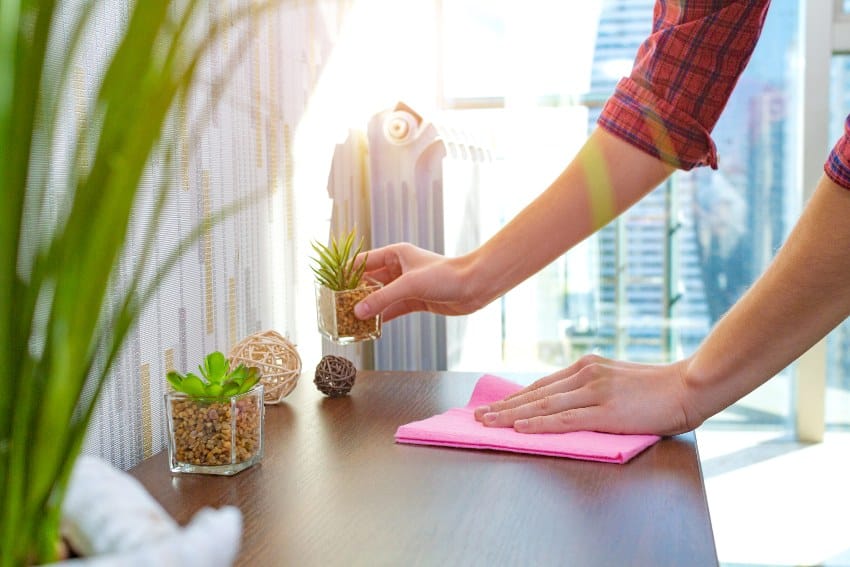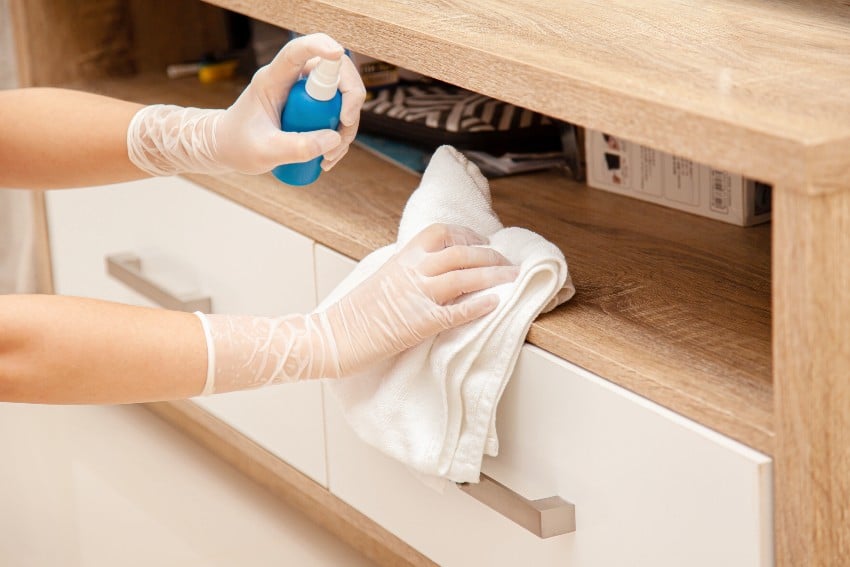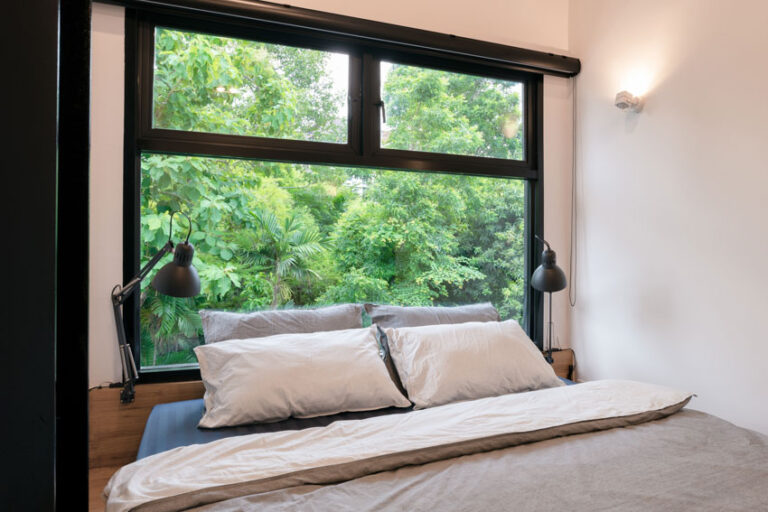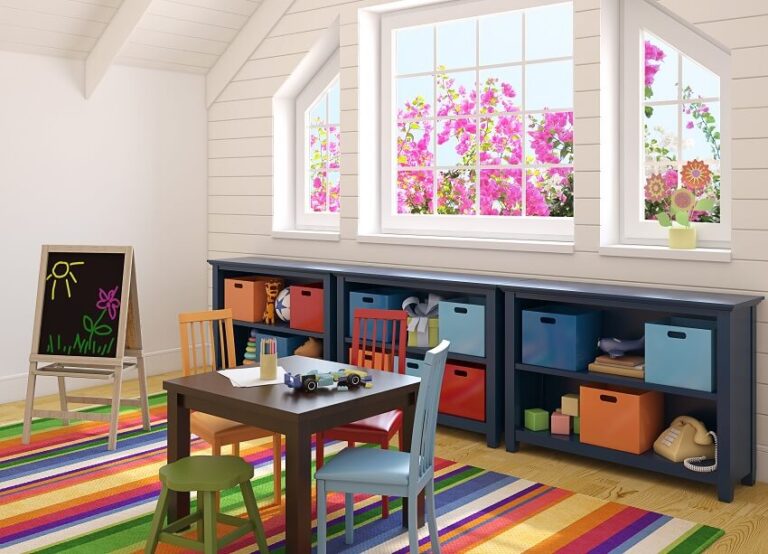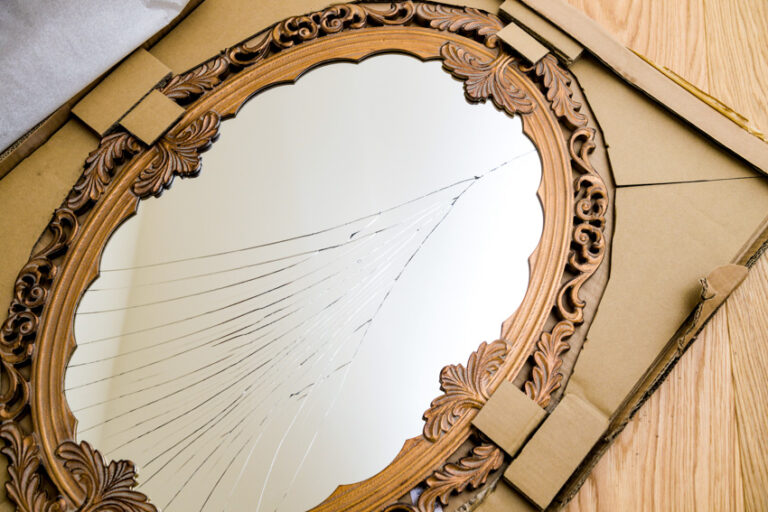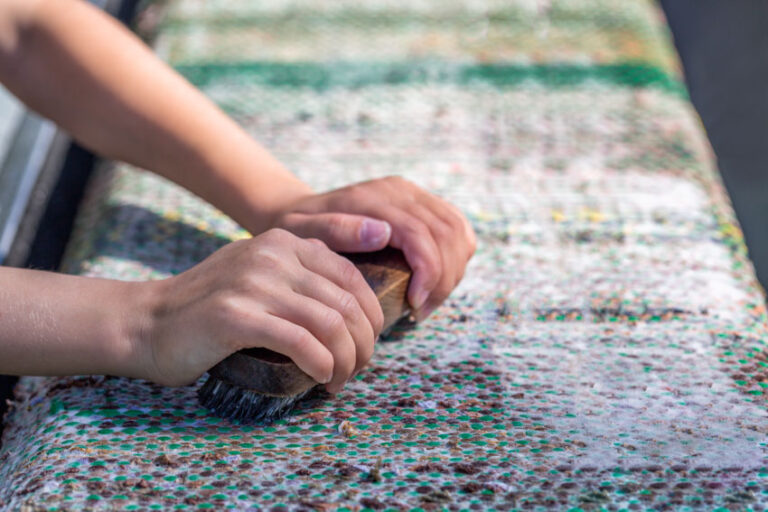How To Disinfect Wood Furniture Naturally With Safe Options
Wood furniture and upkeep seem complicated, but it can be one of the simplest and most effective tasks. An excellent first step is to learn about the item from the seller or the manufacturer’s instructions before purchasing furniture. With the essential information and a few tips, you can effectively disinfect wood furniture, ensuring your cherished pieces are clean and free from harmful germs and bacteria.

It can be really challenging to develop an effective cleaning method that applies to wood furniture pieces all across the board, as there are so many types of stains, finishes, and even wood grains and varieties to work with.
A good rule of thumb is to go with something that is the least harsh when using cleaning solutions. Or at least go with the mildest and eventually work your way up. It would also be wise to work in small sections, testing inconspicuous areas before applying them to an entire furniture piece.
How Do You Disinfect Wood Naturally?
The easiest and most common method is water, vinegar, and olive oil base to clean surface-level dirt on wooden furniture pieces.
This type of cleaning solution is great for gently cleaning varnished wooden furniture pieces or even just slightly sprucing them up a bit at the end of the day. The olive oil ingredient provides luster and hydration for your wooden pieces.
On the other hand, the vinegar will help you remove any grease that clings to the surface. You can rest assured that if used correctly, it won’t damage the wood.
• You’ll need 250 ml water, 250 ml vinegar, and 1 tablespoon of olive oil.
You can use a spray bottle after combining these in it. Remember to shake it vigorously before and after using, or the oil will separate very rapidly. Additionally, before shaking it, ensure the lid is tightly fastened, so it doesn’t spill over.
• With the use of lemon juice, polish and clean wooden furniture.
This solution is quite similar to the first, except that lemon juice is used in place of the water. Additionally, it’s great for giving the wooden furniture you clean up the added benefit of a citrusy, summery scent.
Use the following proportions to make as much as you need:
• 2/vol. vinegar
• 2 components olive oil
• 1 component lemon juice
You can combine these items, just like with the previous solution, in a spray bottle or a bowl, depending on the actual amount of the solution you need to clean up your wooden furniture. Then, get cleaning! Utilize your homemade furniture cleaner to clean a wooden table or any other pieces you have at home.
As we’ve previously mentioned, always start with small test areas before fully committing to a specific cleaning method or cleaning product for your wood. This will help you ensure that the cleanser or a particular product you’re using will not incur any changes of color in the wood or any other similar adverse reactions.
To remove any dirt-crusted wooden piece, give the item a quick wipe-down with water. This works particularly well for any residual food particles that might have been left behind during mealtimes.
Use a thick and dry paper towel to give it a finishing touch and buff it out. You may also fold the paper towel into a point and use it to clean tight spaces, such as corners or crevices, which are notorious for harboring dirt. You can choose how to apply the solution to the surface, such as spraying it on or dipping a rag into it.
To polish the table, start by rubbing a piece of kitchen paper dampened in large circles, moving toward the wood grain.
Repeat wiping the table’s surface with dry kitchen paper to remove any residual solution. If you want the furniture to have more of a sheen, you can use this paper to buff it and give it that look.
Attention must be paid to corners or angles that are particularly narrow since extra solutions may collect there. Once more, fold your paper towel into a point to access all problematic regions that are particularly hard to reach. For the most thorough cleaning of your table, make sure that you use a paper towel that is sturdy and absorbent.
Cleaning your wooden furniture at home can definitely be done with nothing more than using natural products. It can be pretty simple, and it doesn’t have to be fancy at all. Keep them close to you and easily within reach so that you can clean up your furniture in the event of any spills.
What Disinfectant Is Safe To Use On Wood Furniture?
You might try using Seventh Generation Disinfecting Wipes, which are effective at killing germs because they include thymol, a component of thyme oil. See them at Amazon [sponsored link]
The manufacturer of this product asserts that it can clean and disinfect in a single step, and it will not cause any damage to the finishes of your wooden furniture. In addition to this, it is not toxic to food. Therefore, it can be used on food-related surfaces such as cutting boards, bread boxes, and compost bins.
You may also try Bleach and Alcohol Solutions.
To effectively disinfect surfaces, a solution consisting of one part chlorine bleach (Clorox) and thirty-two parts water (one-half cup of bleach to one gallon of water or four teaspoons of bleach to one quart of water) should be allowed to sit on the surface for five to ten minutes.
This solution is safe enough for most wooden surfaces and won’t end up damaging them, either.If you use an alcohol that is 60 to 90 percent concentration it should kill virus germs and bacteria like E.coli and salmonella. Source: Healthline
Hydrogen peroxide, which can be used as a disinfectant in its frequently available 3% solution or diluted to a concentration of 5%, is another substance you can use or even experiment with. A solution of 70% alcohol was also tested, and based on the results, it appears safe for usage.
Using an alcohol and hydrogen peroxide concoction helps to allow the solution to sit on the wooden surface a little bit longer than usual. This will enable you to help sanitize the surface even more. This is great if you have pets, children, or other people who can benefit from the added sanitization of your wooden furniture.
Naturally, we still suggest conducting a spot test with any cleaner you select on a tiny section of the wooden surfaces you plan to clean. It would be best to verify that it does not cause discoloration or damage.
Disinfecting The Wood Without Damaging The Finish
You regularly dust and polish your wood furniture. Still, with time the dust and polishes combine to produce a dark film on shelves, tables, and chairs. You must perform frequent deep cleaning to ensure that your wooden furniture stays in its best shape and form.
Here are some cleaning tips for wood furniture that won’t harm the finish:
• Dust the furniture to get rid of any visible dirt. This takes care of light soiling and any amount of surface-level dirt.
This cleaning method is usually already good enough if the wood has no stains. But if there are stubborn stains that you need to take care of, you can proceed with the next few steps.
• Start with the mildest cleaning solution and work your way up as necessary. Try out a diluted mixture of water and dish washing soap.
• Wipe the entire piece after dipping a soft rag in the mixture and wringing it out. It would be best if you go over it with a damp cloth.
• Avoid over-wetting the wood, and wash your cloth frequently.
• Use a second, clean cloth to completely dry the furniture.
Here’s how to clean discolored or otherwise problematic wood furniture:
• You may revive an antique by learning to clean old wooden furniture with a brand-new coating of polish. This method is more old-fashioned than the others but works just as well.
• Boiling water is used to steep two tea bags.
• Wait until the tea is at room temperature.
• Use a delicate cloth to wash the wood after soaking it in tea until it is moist.
• The tannic acid in tea is excellent for keeping it in good condition. You’ll notice that your surfaces will glow or take on a certain amount of shine soon after a basic wipe-down.
Here’s how to get rid of water stains on wood after someone spills a hot or cold beverage on the table.
• Apply some non-gel toothpaste to the area, then use a soft cloth to rub until the stain is removed.
• Mix toothpaste and baking soda in equal quantities for tough stains.
• Remove the toothpaste with a clean, damp cloth, and then completely dry the area.
To get rid of an ink stain:
• Make a thin paste by combining 1 teaspoon of water with 1 tablespoon of baking soda.
• Apply to the stain and gently massage with a soft cloth to remove it.
• Remove the toothpaste with a clean, damp cloth, and then completely dry the area.
• After cleaning your furniture, apply a coat of wood polish to add luster and protect the finish.
• You may also use some homemade furniture polish.
• Use commercial-grade lemon oil. Additionally, you can create a homemade polish by combining 1/4 cup white vinegar with 1 cup olive oil. Pour it onto a soft cloth and rub the wood against the grain till it is shiny and buff.
You may prolong the lifespan of your assets by learning how to properly clean wood furniture.
Disinfecting Untreated Wood?
Untreated wood furniture, unfinished or unsealed, responds like a brand-new, unused board and is porous and absorbent.
Harsh chemical cleansers are not an option because the wood may be harmed or stained due to the liquid it absorbs. Natural cleaning techniques provide a safe substitute that is safe for both people and furniture.
Regular Dusting
Regular dusting preserves the appearance of furniture without endangering the wood. Without dusting, debris may, over time, cake on, making removal more challenging. Dust can be frequently removed with a soft cloth or feather duster.
Another option is to vacuum with an upholstery brush attachment. To get rid of dust and dirt trapped in crevices, rub a soft-bristled brush, like a toothbrush, an artist’s brush, or a makeup brush.
Soap
When some liquids drip onto the arm of wooden furniture, for example, and then harden there, goop can form. This can be seen when the furniture piece is used or when direct light is shone directly on it.
When added to a bucket of room-temperature water, one or two squirts of natural dish soap create a gentle cleanser that can be used on unfinished and untreated wood. After soaking a sponge or gentle cloth in the solution, wring off most of the liquid until the sponge or cloth is only slightly damp.
The dirty areas should be wiped down with a damp cloth or rag, then finished with another soft, dry cloth. You should keep the surface at its driest possible state during this procedure to prevent damage.
If the dirty area is tough to clean, using a brush with soft bristles can help scrub the grime away. Dish soaps made from natural ingredients can be found in some stores selling organic products.
Homemade Solutions
When it comes to cleaning fingerprints, filth, and general debris that has been left on unfinished furniture, white vinegar comes to the rescue. After adding one tablespoon of vinegar to a spray bottle with a little bit of water:
• Apply the solution to the affected region.
• Remove it with a towel that has been dampened with water.
• After cleaning an area, wipe it down with a dry cloth so the moisture doesn’t get absorbed into the wood.
For more intensive cleaning, use a much stronger vinegar solution, such as one composed of equal parts of vinegar and water.
For sticky messes
Chewing gum and pine tree sap produce a sticky mess that may appear difficult to remove from wood without causing any damage to the furniture in question.
After placing a few ice cubes in a sandwich bag with a zipper, place the bag over the problematic area and hold it until the gum or sap becomes more solid and less tacky. Utilizing a plastic knife or spatula, carefully chip away at the calcified mass until it is gone.
What Should You Not Use To Clean Wood?
Many different cleaning chemicals have the potential to damage your wooden furniture in a variety of ways, including denting, scratching, warping, peeling, and stripping, as well as causing damage from water. Harsh chemicals and scents can erode the finish of your wood, reducing the natural shine and value of the material overall.
Be sure to steer clear of the following when picking out a cleaning procedure for your hardwood floors:
Anything with Vinegar and Ammonia
The grime on your furniture and the finish on the wood itself will be eaten away by cleaning chemicals with a base of vinegar or ammonia as their primary solvent.
After some time, the acid will wear down the actual material structure of the wood, leaving you with splotchy sections that are impossible to restore. You should opt for a cleanser that has a neutral pH level.
Oil soap
Cleaners that contain oil are fantastic for making your wood appear bright. Still, they frequently merely trap dust and debris on top of the varnish, which causes your furniture to turn yellow over time. This residue can re-attract soil, which, over time, can cause dulling and even irreversible damage.
Excess Water
It is a good idea to grab a rag and a bucket of water and go to town on your wooden furniture. Still, if you use too much water, the liquid can absorb the wood, causing the wood to swell and potentially crack at the seams.
If you use too much water, the liquid can absorb the wood. This results in a mess that may be very difficult to clean up and require replacing the item in question. It should be enough to use a dry rag and a few spritzes of the liquid.
Final Word
Wood furniture is one of the staples in any home design. It’s easy to understand why. Wood is known to stand the test of time. It’s a choice bound to last you for years or even generations. A well-made piece of wood furniture is bound to be a classic. And it’s something that you can consider an anchor to any space you happen to be decorating at home.
There’s so much more to this than meets the eye, though. If you want your precious wood furniture items to last for a long time, you will need to use the techniques shared here to help ensure your wood furniture remains looking beautiful.
Visit our guide on how to clean cherry wood cabinets for more related content.

